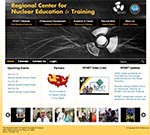
Regional Center for Nuclear Energy Education and Training (RCNET)
http://www.gonuke.org/
Indian River State College in Fort Pierce, Florida is home to the Regional Center for Nuclear Education and Training (RCNET). The Center, a consortium of 46 colleges and universities and 35 industry partners, aims to meet the demand for skilled nuclear technicians in a unified, systematic way. Collectively, this group represents a critical mass of training and industry experts. Some of the goals of RCNET are to create a comprehensive curriculum for technician tracks, develop or enhance training programs at regional colleges, provide career paths to higher education and undergraduate research, and provide remote access to expensive and unique training components. RCNET serves the nuclear industry as a training resource, curriculum repository, and source of expertise, while improving communications and collaboration across the industry.



